Zoom
Trash

Susie Gridley
Intervention Specialist K-5 for Mentor Public Schools, Rice Elementary
Deborah Sampson. Education & Resources - National Women's History Museum - NWHM. Deborah Sampson, who fought in the American Revolution disguised as the soldier Robert Shurtlieff, was born on December 1, 1760 in Plymton, Massachusetts, near Plymouth.
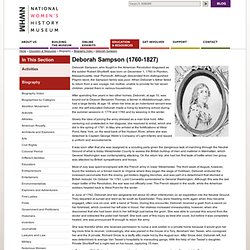
Although descended from distinguished Pilgrim stock, the Sampson family was poor. When Deborah’s father failed to return from a sea voyage, her mother, unable to provide for her seven children, placed them in various households. After spending five years in two other homes, Deborah, at age 10, was bound out to Deacon Benjamin Thomas, a farmer in Middleborough, who had a large family.
At age 18, when her time as an indentured servant was over, the self-educated Deborah made a living by teaching school during the summer sessions in 1779 and 1780 and by weaving in the winter. Slowly the idea of joining the army dressed as a man took hold. Most of July was spent encamped with the French army in lower Westchester. For over two years, Deborah’s true sex had escaped detection. Deborah Sampson: Woman Warrior of the American Revolution. Deborah Sampson was a secret soldier who disguised herself as a man and fought in the American Revolution.
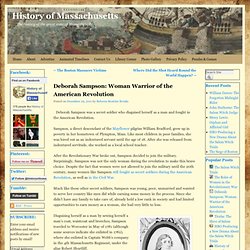
Deborah Samson. Deborah Samson war heroineBorn: 1760Birthplace: Plympton, Massachusetts The oldest of at least seven children, Samson learned responsibility at an early age.

Her father abandoned the family when she was five. A few years later Samson became an indentured servant, taking care of several boys. As the Revolutionary War got underway, she was infuriated by British action and questioned why she was not allowed to fight for her country. Died: 1827 Fact Monster/Information Please® Database, © 2007 Pearson Education, Inc.
More on Deborah Samson from Fact Monster: Selected Biographies: S - Selected biographies of well-known people and fictional characters. Liberty`s Kids #34 Deborah Samson Soldier of the Revolution. Deborah Sampson. Deborah Sampson was the first known American woman to impersonate a man in order to join the army and take part in combat.
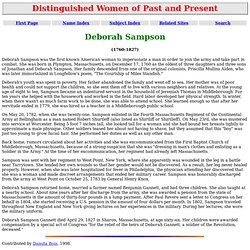
She was born in Plympton, Massachusetts, on December 17, 1760 as the oldest of three daughters and three sons of Jonathan and Deborah Sampson. Her family descended from one of the original colonists, Priscilla Mullins Alden, who was later immortalized in Longfellow's poem, "The Courtship of Miles Standish. " Deborah Sampson. Deborah Sampson Gannett (December 17, 1760 – April 29, 1827[1][2]), better known as Deborah Sampson, was an ]] woman who disguised as a man in order to serve in the Continental Army during the American Revolutionary War.
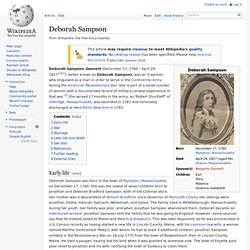
She is part of a small number of women with a documented record of military combat experience in that war.[3] She served 17 months in the army, as "Robert Shurtlieff" of Uxbridge, Massachusetts, was wounded in 1782 and honorably discharged at West Point, New York in 1783. Early life[edit] Deborah lived in several different households: first with a spinster, then with the widow of Reverend Peter Thatcher, and finally, in 1770, she ended up an indentured servant in a farm which was owned by Deacon Jeremiah and Susanna Thomas. There she lived from the age of 10 to 18. History At Play- A REVOLUTION OF HER OWN- Deborah Samson Gannett. Mercy Otis Warren. Mercy Otis Warren (September 24, 1728 – October 19, 1814) Mercy Otis Warren. Mercy Otis Warren (September 14, [September 25, New Style][1] 1728 – October 19, 1814) was a political writer and propagandist of the American Revolution.
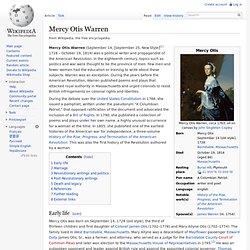
In the eighteenth century, topics such as politics and war were thought to be the province of men. Few men and fewer women had the education or training to write about these subjects. Warren was an exception. During the years before the American Revolution, Warren published poems and plays that attacked royal authority in Massachusetts and urged colonists to resist British infringements on colonial rights and liberties.
Mercy Otis Warren. By Pamela Kline and Paul Pavao Known as the "Conscience of the American Revolution," Mercy Otis Warren accomplished things unknown to women in her time.
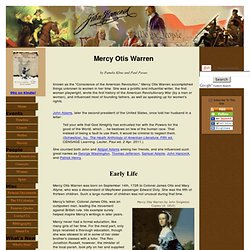
She was a prolific and influential writer, the first woman playwright, wrote the first history of the American Revolutionary War (by a man or woman), and influenced most of founding fathers, as well as speaking up for women's rights. John Adams, later the second president of the United States, once told her husband in a letter: Tell your wife that God Almighty has entrusted her with the Powers for the good of the World, which ... he bestows on few of the human race. That instead of being a fault to use them, it would be criminal to neglect them.
Mercy Otis Warren.mov. American Revolution: Mercy Otis Warren. As of July 1, 2013 ThinkQuest has been discontinued.

We would like to thank everyone for being a part of the ThinkQuest global community: Students - For your limitless creativity and innovation, which inspires us all. Teachers - For your passion in guiding students on their quest. Partners - For your unwavering support and evangelism. Parents - For supporting the use of technology not only as an instrument of learning, but as a means of creating knowledge. The Righteous Revolution of Mercy Otis Warren. Mercy Otis Warren - Founding Mother. Phillis Wheatley. Phillis Wheatley.
Phillis Wheatley (May 8, 1753 – December 5, 1784) was both the second published African-American poet and first published African-American woman.[1] Born in Senegambia, she was sold into slavery at the age of 7 and transported to North America.

She was purchased by the Wheatley family of Boston, who taught her to read and write, and encouraged her poetry when they saw her talent. The publication of her Poems on Various Subjects, Religious and Moral (1773) brought her fame both in England and the American colonies; figures such as George Washington praised her work. During Wheatley's visit to England with her master's son, the African-American poet Jupiter Hammon praised her work in his own poem.
Wheatley was emancipated after the death of her master John Wheatley.[2] She married soon after. Two of her children died as infants. Early life[edit] Education & Resources - National Women's History Museum - NWHM. One of America’s first poets, Phillis Wheatley was born in 1753 in Africa.
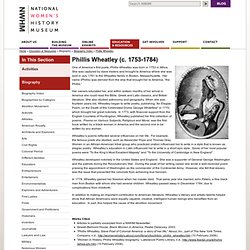
She was captured by slave traders and brought to America where she was sold in July 1761 to the Wheatley family in Boston, Massachusetts. Her name (Phillis) was derived from the ship that brought her to America, “the Phillis.” Her owners educated her, and within sixteen months of her arrival in America she could read the Bible, Greek and Latin classics, and British literature. She also studied astronomy and geography. Phillis Wheatley. Phillis Wheatley Biography. Having been kidnapped from West Africa and enslaved, Phillis Wheatley became the first African American and one of the first women to publish a book of poetry in the colonies, doing so in 1773. Synopsis Born in Senegal/Gambia in about 1753, poet Phillis Wheatley was brought to Boston, Massachusetts, on a slave ship in 1761 and was purchased by John Wheatley as a personal servant to his wife.
The Wheatleys educated Phillis and she soon mastered Latin and Greek, going on to write highly acclaimed poetry. She published her first poem in 1767 and her first volume of verse, Poems on Various Subjects, Religious and Moral, in 1773. Having been freed from slavery, she later married and struggled financially, with Wheatley unable to find a publisher for her second volume of poems. Phillis Wheatley - Slave Poet of Colonial America. (about 1753-1754 - December 5, 1784) sometimes misspelled as Phyllis Wheatley Phillis Wheatley was born in Africa (probably Senegal) about 1753 or 1754.
Phillis Wheatley: In-class Video Presentation. James Armistead. James Armistead Biography. James Armistead was an enslaved African American, best known for his work as a spy during the American Revolution. Synopsis James Armistead was born into slavery in Virginia around 1748. Armistead enlisted in the Revolutionary War under General Lafayette. Working as a spy, Armistead gained the trust of General Cornwallis and Benedict Arnold, providing information that allowed American forces to prevail at the Battle of Yorktown. James Armistead, Patriot Spy - Black History Month: Unsung Heroes.
Wars are rarely fought without the use of spies and the American Revolution was no exception. Arguably, the most important Revolutionary War spy was a slave named James Armistead. Born around 1748 in New Kent, Va., Armistead was given permission by his master to join the revolutionary cause. Liberty`s Kids #35 James Armistead. James Armistead. James Armistead went from slave, to spy, to Revolutionary War hero - National Historic Americans. 1760 Virginia was the birthplace of a very effective spy during the American Revolution. James Armistead, born a slave on William Armistead’s plantation, gained permission from his owner to volunteer for the army in 1781.
When he learned the war was about liberty and not money or land, he felt he needed to be a part of the effort. He was assigned to serve the French forces under the command of Marquis de Lafayette. While serving under the Marquis, Armistead pretended to be a runaway slave hired by a British spy. He was able to gain the confidence of British General Cornwallis and American General Benedict Arnold.
In 1781, General Lafayette received a message from General George Washington stating the need for his forces to keep him informed regarding Cornwallis’s movements and strategies. Nate interviews James Armistead Lafayette. James Armistead. Marquis de Lafayette. Gilbert du Motier, Marquis de Lafayette. In the American Revolution, La Fayette served as a major-general in the Continental Army under George Washington. Wounded during the Battle of Brandywine, he still managed to organize a successful retreat.
He served with distinction in the Battle of Rhode Island. Marquis de Lafayette Biography. Professor Interviewed for Lafayette Documentary on PBS. The Marquis de Lafayette. The Marquis de Lafayette : The Colonial Williamsburg Official History & Citizenship Site. Liberty's Kids #22 Lafayette Arrives. Crispus Attucks. Crispus Attucks. Crispus Attucks (c. 1723 – March 5, 1770) may have been an American slave or freeman, merchant seaman and dockworker of Wampanoag and African descent.
He was the first casualty of the Boston Massacre, in Boston, Massachusetts,[2] and is widely considered to be the first American casualty in the American Revolutionary War. Little is known for certain about Crispus Attucks beyond that he, along with Samuel Gray and James Caldwell, died "on the spot" during the incident.[3] Two major sources of eyewitness testimony about the Boston Massacre, both published in 1770, did not refer to Attucks as a black man or "Negro"; it appeared that Bostonians accepted him as mixed race. Historians disagree on whether Crispus Attucks was a free man or an escaped slave; but agree that he was of Wampanoag and African descent. Who Was Crispus Attucks? Early Portrait of Crispus Attucks (c) Learning Company. The Boston Massacre: America the Story of Us. Crispus Attucks Biography. Africans in America/Part 2/Crispus Attucks. Revolution in Boston.